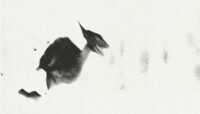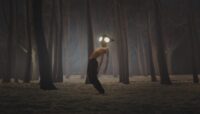
“No Intention”
from the album Bitte Orca
2009
iTunes
Of all the New York art-rock bands to command column inches in the New York Times arts section and elicit echolalic reporting of new singles and remixes this year (like Animal Collective circa January or Grizzly Bear circa April/May), Dirty Projectors have had the most circuitous and unlikely ascension. The band started as a way for Yale composition graduate Dave Longstreth to mix his orchestral leanings with R&B grooves and prog-rock pretension. His third album, 2005’s The Getty Address, was a concept album about Don Henley. (Seriously.) His fourth album, 2007’s Rise Above, was a reinterpretation of Black Flag’s Rise Above that Longstreth arranged without listening to the original for 15 years. It’s hard to believe that anyone would have pegged Dirty Projectors as the next band to leap from obscurity to blog-hype.
But then came the excellent “Knotty Pine,” the group’s collaboration with David Byrne on the charity comp Dark Was the Night, which suddenly made the Projectors a hot prospect. But that proved to be a meager palate whetting compared to the broken, art-rock R&B grind of “Stillness is the Move,” which sounds like it was dropped in from a long-lost Aaliyah album (thanks to the singing of guitarist Amber Coffman), the first single from the band’s suddenly hotly anticipated fifth, and best, album, Bitte Orca.
Given the relative accessibilty of “Stillness is the Move” compared to the rest of Dirty Projectors’ catalog, it’s tempting to call Bitte Orca Dirty Projectors’ pop breakthrough. That’s not really the case because Bitte Orca, and “Stillness is the Move,” is a refinement and perfection of all the ideas that Longstreth has batted around since he was making dense orchestral records; the collision of vocal harmonies, percussive R&B grooves, genre curveballs, high register, taut guitar lines that sound like they’re about to break and orchestral passages that add lush layers to Longstreth’s already dense arrangements.
Bitte Orca opens with the dusty “Cannibal Resource,” a Longstreth-led harmony and string collision that has handclaps in lieu of a snare backbeat. Longstreth’s voice was something of a deal-breaker on past Projectors albums (its warble is idiosyncratic and an acquired taste), but on Bitte he’s honed his squawk into a multi-note behemoth, capable of growling or harmonizing. “Useful Chamber,” the album’s centerpiece, is his spotlight moment (like “Stillness” is for Coffman and “Two Doves” is for bassist Angel Deradoorian), as he rides the song’s multi-part prog-rock explosion, nailing the talking bridge, the crushing stoner-rock chorus and the harmonic build of the Spartan verses.
Dirty Projectors have gained notoriety for how quickly and frequently the band cycles through members (every album has had a different cast), but the period from Rise Above to Bitte Orca has been the lineup’s most consistent, leading to great rewards for keeping things constant. It’s hard to imagine a new group still feeling each other out being able to pull of the vocally dexterous “Remade Horizon,” which features Deradoorian, Coffman, and Longstreth harmonizing in concentric circles, lining up sometimes, and floating on their own the rest, or creating the tension of late R&B-tinged highlights “No Intention” or “Fluorescent Half Dome.” These sound like the work of a band coming together creatively, hitting every right note and reaching peaks that none could hit alone.
“Stillness is the Move” is sure to dominate a lot of the talk regarding Bitte Orca, and probably rightfully. But what can’t be overlooked is how much of an achievement the album is. “Stillness” might provide the entrance point, but Bitte Orca is the kind of album that is best taken from start to finish, where the songs and musical themes are allowed to grow, endear, and impress.


